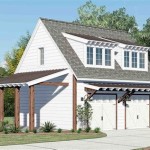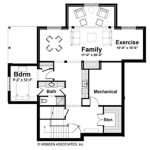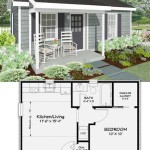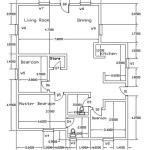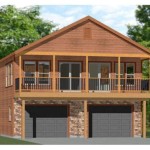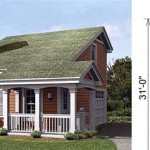Small House Plans With Basement Under 1000 Sq Ft: Maximizing Space and Functionality
The rising costs of land and construction materials have spurred considerable interest in smaller, more efficient home designs. Among the popular options are small house plans with basements, allowing homeowners to maximize living space without expanding the ground-floor footprint. For those seeking to build a home under 1000 square feet, incorporating a basement provides significant benefits in terms of storage, living areas, and potential for future expansion. This article will explore the key considerations when developing small house plans with basements, focusing on design elements, code compliance, and cost-effectiveness.
Understanding the Benefits of a Basement in a Small House
Integrating a basement into a small house plan offers numerous advantages beyond simply increasing square footage. The most immediate benefit is expanded storage capacity. In homes under 1000 square feet, dedicating valuable above-ground space to storage can significantly impact livability. A basement allows for the storage of seasonal items, tools, equipment, and other belongings, freeing up space in the main living areas. Furthermore, a finished basement can serve as a valuable extension of the home’s living space. It can be transformed into a recreation room, home office, guest suite, or even a rental apartment, providing additional income potential. Strategically planning the basement's layout during the initial design phase is crucial to optimizing its functionality.
Beyond the practical benefits, a basement also enhances the resilience of a small home. It provides a safe shelter during severe weather events, particularly in regions prone to tornadoes or hurricanes. The thermal mass of the surrounding earth helps regulate the temperature of the basement, contributing to lower heating and cooling costs for the entire house. This energy efficiency is particularly important in smaller homes where temperature fluctuations can be more noticeable. Additionally, a basement serves as a protective buffer for the foundation, reducing the risk of moisture damage and structural problems.
Building a basement also offers the flexibility for future expansion. While the initial construction cost is higher, the basement provides a readily available space that can be finished later as needs and budget allow. This phased approach to home construction can make homeownership more accessible and sustainable over the long term. The basement can be initially used for storage or utilities and subsequently converted into living space as the family grows or financial resources become available.
Key Design Considerations for Small House Plans with Basements
Designing a small house plan with a basement requires careful consideration of several factors, including the size and configuration of the basement, the location of stairs and access points, and the integration of natural light. The size and shape of the basement should complement the overall design of the house. A full basement, extending under the entire footprint of the house, typically offers the most flexibility, while a partial basement can be a more cost-effective option if only specific areas require additional space. The configuration should also consider the placement of utility systems, such as the furnace, water heater, and electrical panel.
The placement of the stairs is a critical design element. The stairs should be easily accessible from the main living areas and should comply with local building codes regarding width, rise, and run. The location of the stairs can significantly impact the layout of both the main floor and the basement, so careful planning is essential. Consideration should be given to whether the stairs will be open or enclosed, and whether they will lead directly into the basement or into a small landing area.
Introducing natural light into the basement is another important consideration. While basements are often perceived as dark and damp spaces, strategic design can bring in sunlight and improve the overall ambiance. Options include installing egress windows, which are large enough to allow for emergency escape, and incorporating a walk-out basement design, where one side of the basement is exposed to the ground. Light wells can also be used to channel sunlight into smaller basement windows. The use of light-colored finishes and reflective surfaces in the basement can further enhance the brightness and create a more inviting atmosphere.
Beyond the physical design, accessibility should also be a primary concern. Ensuring that the basement is easily accessible for all occupants, including those with mobility limitations, is important for creating a truly functional and inclusive home. This may involve incorporating ramps or elevators, wider doorways, and other accessibility features into the design.
Navigating Building Codes and Regulations
Building codes and regulations play a crucial role in the design and construction of small house plans with basements. Compliance with these codes is essential for ensuring the safety and structural integrity of the home. Local building codes typically address various aspects of basement construction, including foundation requirements, waterproofing, insulation, ventilation, and egress.
Foundation requirements are particularly important. The foundation must be designed to withstand the weight of the house and the pressure of the surrounding soil. The type of foundation system used will depend on the soil conditions, the climate, and the local building codes. Common foundation types include poured concrete walls, concrete block walls, and insulated concrete forms (ICFs). Proper drainage is also essential to prevent water from accumulating around the foundation and causing damage.
Waterproofing is another critical aspect of basement construction. Basements are inherently susceptible to moisture intrusion, so effective waterproofing measures are necessary to prevent leaks and mold growth. Waterproofing techniques include applying a waterproof coating to the exterior of the foundation walls, installing a drainage system around the foundation, and using a vapor barrier on the interior walls. Proper ventilation is also important for controlling moisture levels in the basement.
Egress requirements are particularly stringent for basements that are used as living spaces. Egress windows are required in all habitable basement rooms to provide a means of escape in case of fire or other emergencies. These windows must meet specific size and height requirements to ensure that they are easily accessible. In some cases, a walk-out basement with a door leading directly to the exterior may be required.
It is crucial to consult with a qualified architect or engineer to ensure that the small house plan with a basement complies with all applicable building codes and regulations. These professionals can provide guidance on the best construction methods, materials, and techniques for ensuring the safety and durability of the home.
Cost Considerations and Budgeting
Building a small house with a basement involves significant cost considerations. The added cost of excavating and constructing the basement can increase the overall project budget compared to building a similar-sized house without a basement. However, the increased living space and potential for future expansion can offset this initial cost over the long term.
The cost of building a basement will vary depending on several factors, including the size and configuration of the basement, the soil conditions, the accessibility of the site, and the level of finishing. Excavation costs can be significant, particularly if the site is rocky or requires extensive digging. Foundation costs will depend on the type of foundation system used and the complexity of the design.
Finishing the basement will also add to the overall cost. The level of finishing can range from simply framing and insulating the walls to creating a fully finished living space with flooring, drywall, paint, and fixtures. The cost of finishing will depend on the materials used and the complexity of the design. It is important to prioritize essential elements, such as waterproofing, insulation, and egress, before focusing on cosmetic finishes.
To effectively budget for a small house plan with a basement, it is essential to obtain detailed cost estimates from contractors and suppliers. These estimates should include all aspects of the project, from excavation to finishing. It is also important to factor in contingency costs to account for unexpected expenses or delays.
Exploring cost-saving strategies can help to make the project more affordable. These strategies may include using cost-effective materials, simplifying the design, and performing some of the work yourself. For example, opting for a partial basement instead of a full basement can significantly reduce excavation and foundation costs. Similarly, using unfinished concrete floors instead of expensive flooring materials can save money on finishing costs.
Ultimately, the decision to build a small house with a basement is a personal one that depends on individual needs, preferences, and budget. Careful planning and budgeting can help to ensure that the project is completed successfully and within budget.

House Plans Under 1000 Square Feet

Our Top 1 000 Sq Ft House Plans Houseplans Blog Com

House Plans Under 1000 Square Feet

Tiny House Plans And Small 1 Story Below 1000 Sq Ft

Our Top 1 000 Sq Ft House Plans Houseplans Blog Com

House Plans Under 1000 Square Feet

59 9imr 61 4 M2 660 Sq Foot 2 Bedroom Small Home Floor Plan Granny Flat Under 1000 Bed House Plans Design

Our Top 1 000 Sq Ft House Plans Houseplans Blog Com

Tiny House Plans And Small 1 Story Below 1000 Sq Ft
How Much It Should Cost To Get Home Elevation Floor Plan Designs For Double Story 1000 Sq Ft 20x40 Small Design Quora
Related Posts

